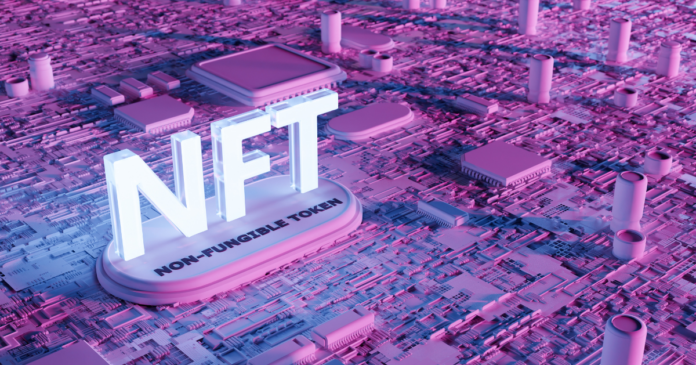In a surprising turn of events, the demand for NFTs plummeted by a staggering 98% within a short period.
In this article, we delve into the underlying factors that led to this sharp decline in NFT interest.
1) Saturation and Hype Fatigue
At the peak of the NFT frenzy, the market witnessed an influx of NFT projects. Ranging from digital art and collectibles to virtual real estate and more. The rapid expansion and saturation of the market led to a decrease in the perceived scarcity and exclusivity of NFTs. As a result, collectors and investors became more discerning. Losing interest in projects that failed to offer genuine value or unique propositions.
Moreover, the hype surrounding NFTs reached a fever pitch, attracting a wide range of speculators and opportunists. As the initial excitement subsided, many speculators withdrew from the market. Causing a significant drop in demand.
According to Bloomberg, NFT monthly trading volumes are down 95% from the $17B January 2022 peak.
And creator royalities are down 98% from peak to only $4.3M in July.
In the history of asset markets, I don’t think we’ve ever witnessed such a catastrophic destruction of demand. pic.twitter.com/qeyGrhGB0G
— Beanie (@beaniemaxi) August 5, 2023
2) Overpriced and Speculative Nature
During the peak of NFT mania, some digital art pieces and collectibles fetched astronomical prices, creating headlines and fuelling the perception that NFTs were a lucrative investment. However, as with any speculative asset, such exorbitant prices were unsustainable, and the bubble eventually burst.
Many investors who purchased NFTs as speculative assets faced severe losses when the market corrected itself. As a result, a sense of caution permeated the NFT space, leading to a sharp drop in demand.
3) Lack of Real-World Utility
While NFTs demonstrated their potential in the art and collectibles domain, the broader adoption of NFTs outside the crypto community remained limited. Many enthusiasts believed that NFTs had the potential to revolutionize various industries. Such as gaming, real estate, and intellectual property rights. However, the tangible integration of NFTs into these sectors faced numerous hurdles and challenges.
As the initial hype subsided, investors and collectors sought NFT projects that showcased practical use cases and real-world utility. The lack of significant progress in this regard contributed to the decline in demand.
People buying NFTs via bids on Blur — mostly airdrop farmers — are down about 50,000 ETH year-to-date in realized losses.
While returns were pretty flat during Season 1, the losses accelerated sharply in Season 2. pic.twitter.com/zUmLPP9Q5w
— NFTstats.eth (@punk9059) August 4, 2023
4) Environmental Concerns
Blockchain technology, which underpins NFTs, has been criticized for its significant energy consumption, particularly Proof of Work (PoW) consensus mechanisms. NFTs on PoW-based blockchains like Ethereum faced backlash due to the perceived environmental impact caused by their energy-intensive operations.
This concern prompted some high-profile artists and celebrities to distance themselves from NFTs, further dampening their appeal and contributing to the drop in demand.
5) Regulatory Uncertainty
The fast-paced and relatively unregulated nature of the NFT market raised concerns among regulatory authorities worldwide. The lack of clear guidelines and potential legal implications regarding NFT ownership, taxation, and copyright infringements deterred both artists and collectors from actively participating in the NFT space.
As regulatory authorities continue to grapple with the complexities of the digital asset space, the uncertainty surrounding NFTs hindered their widespread adoption and dampened demand.
NFTs and the ‘lag effect’
As one of the most speculative corners of Web3, NFT is particularly sensitive to changes disposable income and saving rates.
Investors often liquidate in the depth of bear markets or rotate further down the risk curve either from profits or having… pic.twitter.com/zSbWCPakjF
— Lewis Harland (@_LewisHarland_) August 1, 2023
6) Market Manipulation and Scams
As with any rapidly growing and speculative market, NFTs attracted bad actors and scammers seeking to exploit unsuspecting investors. Reports of market manipulation, fraudulent NFT projects, and even high-profile NFT thefts eroded trust and confidence in the sector.
The prevalence of scams and fraudulent activities in the NFT space contributed to a loss of interest among potential investors and collectors, leading to a significant drop in demand.
Conclusion
The meteoric rise and subsequent decline in NFT demand can be attributed to a combination of factors that emerged during the height of the NFT mania. Saturation, hype fatigue, speculative nature, lack of real-world utility, environmental concerns, regulatory uncertainty, and market manipulation all played significant roles in the 95% drop in NFT demand.
However, it’s essential to note that market corrections are not uncommon in nascent and rapidly evolving industries. While the initial exuberance may have waned, the potential of NFTs as a transformative technology remains intact. As the blockchain ecosystem matures, we can expect the NFT market to recalibrate, with projects that offer genuine value and utility gaining renewed interest and support from both creators and collectors.
⬆️ For more cryptocurrency news, check out the Altcoin Buzz YouTube channel.
⬆️ Our popular Altcoin Buzz Access group generates tons of alpha for our subscribers. And for a limited time, it’s Free. Click the link and join the conversation today.




























